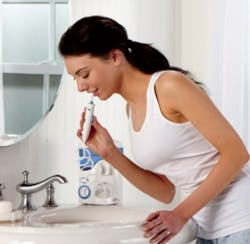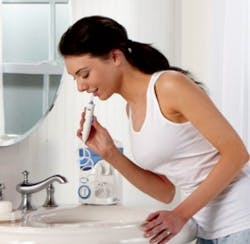A Top 10 list for water flossing
Carol Jahn, RDH, MS
Here are the top 10 reasons for recommending the Waterpik Water Flosser ...
10. It reduces the periodontal infection.
One of the primary benefits of the Water Flosser is that the pulsating action creates a compression/decompression phase that expels subgingival bacteria from the pocket.1 Teeth with no instrumentation for six months or more that were treated with the Water Flosser had reductions in bacteria up to 6 mm.2 When the Water Flosser was compared to both toothbrushing and mouth rinsing with 0.12% chlorhexidine (CHX), only water flossing reduced subgingival bacteria.3 A paper by the American Academy of Periodontology notes that one of the greatest advantages of water flossing is that it “permits patients to participate in maintaining the bacterial reduction that was attained during root planing.”4
9. It reduces the inflammation.
Study after study, many of six months’ duration, has shown that people who add the Water Flosser to daily self-care do better at reducing bleeding and gingivitis than people who don’t use the Water Flosser.5 A 2008 systematic review noted that studies showed there was a beneficial effect of water flossing on the gingival index, bleeding scores, and pocket depth.6 An analysis of water flossing on cytokine production and its relationship to clinical outcomes found that both the Water Flosser and toothbrushing removed plaque, but only the Water Flosser reduced the inflammatory cytokine Interleukin-1β (IL-β). Importantly, the reduction in bleeding was correlated to the reduction in IL-1β, not plaque, providing new evidence as to why the Water Flosser is so effective at reducing inflammation.7
8. It helps people with diabetes.
People with diabetes tend to be at greater risk for periodontal disease and often have more severe gingival inflammation. A study on people with diabetes found that those who used the Water Flosser for three months had a 44% better reduction in bleeding and a 41% better reduction in gingivitis over those who did not use the Water Flosser.8
7. It is safe and gentle around implants.
Maintenance of implants is critical to their long-term survival. A three-month study that compared water flossing with 0.06% CHX delivered with the Pik Pocket™ Tip to rinsing with 0.12% CHX found that those who used the Water Flosser had superior reductions in plaque (29% vs. 9%), bleeding (62% vs. 33%), and gingivitis (45% vs. 10%) over rinsing.9
6. There is nothing better for cleaning around orthodontic appliances.
Keeping orthodontic appliances clean can be tedious and challenging. Water flossing makes it easier. Adolescents age 11 through 17 who used a Water Flosser with the Orthodontic Tip every day for four weeks had three times the reduction in plaque vs. those who used a manual brush and floss and five times the reduction than those who only brushed. The Water Flosser group reduced bleeding by 84.5% from baseline, which was 26% better than brushing and flossing and 53% better than toothbrushing alone.10
5. It gets deeper into the pocket than string floss.
Findings indicate that using the Water Flosser with the Classic Jet Tip results in penetration of approximately 50% of the depth of the pocket. The depth of penetration may vary depending on the depth of the pocket with the deepest penetration often occurring in the deepest (>7 mm) pockets.11 An evaluation of the Pik Pocket™ Tip found it delivers the solution to 90% of the depth of a pocket <6 mm and to 64% of the depth of a pocket >7 mm.12 In contrast, it is widely accepted though not scientifically documented that ideally, floss reaches about 3 mm due to technique and/or anatomical constraints.4. It removes plaque.
A study at the University of Southern California Center for Biofilms found that a three-second application of water flossing with the Classic Jet Tip at medium pressure removed 99.9% of plaque biofilm from the treated area. The teeth utilized for this were colonized by a luxuriant biofilm several micrometers thick. The investigators concluded that the hydraulic forces produced by a Water Flosser with 1,200 pulsations per minute can remove biofilm. The study evaluated the biofilm via scanning electron microscopy. They noted that this method provides a high level of confidence in the direct demonstration of biofilm removal.13 Findings from studies conducted during the past decade that evaluated plaque removal with a traditional whole mouth plaque index have also demonstrated better plaque removal from using a Water Flosser.7,14
3. It is easy to use.
Using the Water Flosser is easier than string flossing because it requires less manual dexterity. It takes about a minute to cleanse the entire mouth. Beyond the initial investment, all you need is water, although the Water Flosser can accommodate most mouth rinses. It is appropriate for people of almost any age; even children as young as 6 with supervision.
2. It is a clinically proven effective alternative to string floss
Three studies have directly compared the Water Flosser to string floss. The first, a four-week study at the University of Nebraska in 2005 found that the Water Flosser with the Classic Jet Tip was up to 93% more effective at reducing bleeding and up to 52% more effective at reducing gingivitis than string floss. Plaque removal was also better.14 In 2011, a four-week study at the University of Amsterdam that compared water flossing with the Classic Jet Tip and the Plaque Seeker® Tip to string floss, found the Water Flosser to be twice as effective at reducing bleeding as string floss. There were no differences between the groups in regard to plaque removal.15 A third four-week study, conducted in 2008 in Canada on adolescents with fixed orthodontic appliances found the Water Flosser with the Orthodontic Tip to be significantly more effective than manual brushing and flossing at removing plaque and reducing bleeding.10
1. It is evidence-based.
The Water Flosser has been evaluated more than 50 times since its introduction in 1962. Clinical findings for reducing bleeding and gingivitis are supported by positive outcomes from more than 20 clinical trials, many of six months duration.4,5 An independent, systematic review had a similar finding.5 The use of the Water Flosser as an effective alternative to string floss is a new concept that has been consistently demonstrated in three separate studies.10,15 The American Academy of Periodontology notes in its review that the greatest benefit from water flossing “is seen in patients who perform inadequate interproximal cleansing.”4 RDH
Carol Jahn, RDH, MS, has been a dental hygienist for 30 years and is the Senior Professional Relations Manager for Water Pik, Inc.
References
1. Bhaskar S et al. Water jet devices in dental practice. J Periodontol 1971; 42:658-664.
2. Cobb CM et al. Ultrastructural examination of human periodontal pockets following the use of an oral irrigation device in vivo. J Periodontol 1988; 59:155-163.
3. Chaves ES et al. Mechanism of irrigation effects on gingivitis. J Periodontol 1994; 65:1016-1021.
4. Greenstein G. Research, Science, and Therapy Committee of the American Academy of Periodontology. Position paper: the role of supra- and subgingival irrigation in the treatment of periodontal diseases. J Periodontol 2005; 76:2015-2027.
5. Jahn CA. The dental water jet: A historical review of literature. J Dent Hyg 2010; 84:122-128.
6. Husseini A et al. The efficacy of oral irrigation in addition to a toothbrush on plaque and the clinical parameters of periodontal inflammation: A systematic review. Int J Dent Hygiene 2008; 6:304-314.
7. Cutler CW et al. Clinical benefits of oral irrigation for periodontitis are related to reduction of pro-inflammatory cytokine levels and plaque. J Clin Periodontol 2000; 27:134-143.
8. Al-Mubarak S et al. Comparative evaluation of adjunctive oral irrigation in diabetes. J Clin Periodontol 2002; 29:295-300.
9. Felo A et al. Effects of subgingival chlorhexidine irrigation on peri-implant maintenance. Am J Dent 1997; 10:107-110.
10 Sharma NC et al. Effect of a dental water jet with orthodontic tip on plaque and bleeding in adolescent patients with fixed orthodontic appliances. Am J Orthod Dentofacial Orthop 2008; 133:565-571.
11. Eakle S et al. Depth of penetration into periodontal pockets with oral irrigation. J Clin Periodontol 1986; 13:39-44.
12. Braun RE, Ciancio SG. Subgingival delivery by an oral irrigation device. J Periodontol 1992; 63:469-472.
13. Gorur A et al. Biofilm removal with a dental water jet. Compend Contin Educ Dent 2009; 30 (Suppl 1):1-6.
14. Barnes CM et al. Comparison of irrigation to floss as an adjunct to toothbrushing: Effect on bleeding, gingivitis, and supragingival plaque. J Clin Dent 2005; 16:71-77.
15. Rosema NAM et al. The effect of different interdental cleaning devices on gingival bleeding. J Int Acad Periodontol 2011; 13:2-10.
Past RDH Issues

